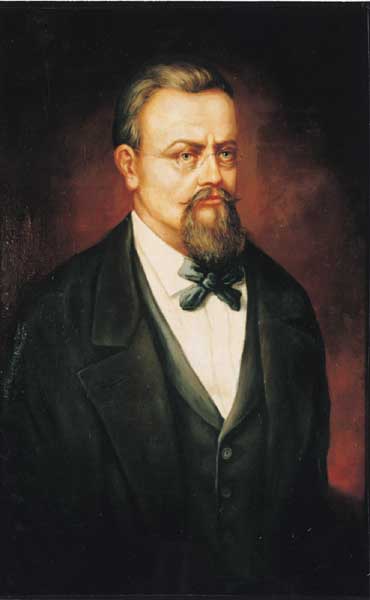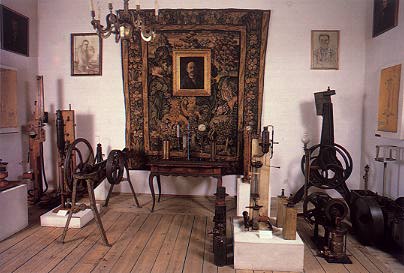Zygmunt Wróblewski

Zygmunt Wróblewski |
Zygmunt Wróblewski was born in Grodno, now in Belarus, in 1845. After graduation from high school in Grodno, he matriculated at the University in Kiev. He interrupted his studies to take part in the Polish January uprising of 1863. He was arrested in July 1863 when he was 18 and sent first to Siberia, then to the Kazan district. The imprisonment lasted till he reached the age of 24. While in Siberia his eyesight deteriorated and blindness threatened. He journeyed to an ophthalmologist in Berlin and after two operations his sight was saved. He started to study, first in Berlin, later in Heidelberg where he studied under Heimholtz who occupied the Physiology Chair He had an excellent auditory memory and used it to enlarge his knowledge. While in Berlin he discussed theories he had formulated during his imprisonment reading materials in the realm of physics. Heimholtz persuaded him to test his theories experimentally. Since he didn't possess the means to rent a laboratory, he sought a position as Assistant and in its quests crisscrossed Europe, eventually being offered the sought position with Prof. Jolly of Munich University. Here he wrote his doctoral thesis. Next he work as an Assistant to Prof. Kundt in Strasburg. Kundt was one of the foremost German experimenters and together they worked on the diffusion of gases by absorbing materials.
In 1876 he was elevated to the position of Docent at the University. Later he even received an invitation to assume the Chair of a Chemistry Department in Japan, but the holder of the chair rescinded his decision to resign from it. In 1880 he utilized a grant he received from the Polish Academy of Science to visit Paris where he managed to gain entry to the laboratory of the Ecole Normale Superieure. There he met Cailletet and this acquaintanceship contributed significantly to the liquefaction of gases he later achieved with Karol Olszewski. While in France he bought the type of apparatus that Cailletet was using to that end. Assuming the Chair of Physics at the Jagiellonian University he set about modernizing the department. Even though the government was providing scant funds for research, he managed to electrify the department. He published extensively in the area of chemistry and had large number of people come to his lectures. Though not a great speaker he impressed students with his excellent memory. He continued his investigation of the properties of gases and it may be that he thus met Karol Olszewski. The two right away undertook the liquefaction of gases. To achieve the goal of liquefying oxygen, they had to build equipment which would permit the achievement of temperature yet lower than those Cailletet permitted. After a number of modifications and the manner of cooling, this proved achievable. On the ninth of April (others say on March 29th) they managed to achieve the liquefaction of oxygen, the first time this had been achieved. At the sight of the liquid oxygen the two scientist embraced each other and began to waltz around the laboratory. The achievement was the more prestigious because up that time oxygen, together with nitrogen, methane, hydrogen and carbon monoxide were gases that resisted liquefaction. After this great success they received scores of letter of congratulation from such eminent scientist as Cailletet, Heimholtz, Jolly and Debray.

The room and istruments employed by Karol Olszewski and Zygmunt Wróblewski in bringing about the liquifation of oxygen in 1883 |
At the meeting of the Academie Francais of 16th of April, 1883 immediately after the reading of the communication that oxygen had been liquified, speculation arose regarding who was the real author of the success. The French believed that it was Cailleter and that Wroblewski working in his laboratory had appropriate the technology, thanks to which he was the first to liquify oxygen. In addition, scientists were surprised that Olszewski and Wroblewski working in their small laboratory could overtake such best such seasoned investigators as Natterer, Andrews, Cailletet and Pictet. The meeting, attended by. among others, Berthelot, Dumas, Debray, Fremy and Cailletet was very agitated. Some participant were eager to demonstrate that Cailetet who maintained he had been the first to liquified oxygen was right. On the other hand the other reminded the meeting that Wroblewski in his account had listed the achievements of the Frenchman. Toward the end of the meeting, the porter approached Debray and handed him a blue envelope. It contained the news that on April 16 the Poles had achieved the liquefaction of nitrogen. An article by Jamina, the Secretary of the Academie Francais, followed in which he accused the Poles of having acted as thieves, by lifting the method enounced by Cailletet. The arguments between the French press and the Poles came go an end when Wroblewski published an article in which he described his and his co-worker's contribution as well as that of Cailleter. It was from that moment on, however, that a controversy arose between the two Polish scientists. Wrobelwski was better know in Europe and he became identified with the liquefaction of air. Olszewski, who spent almost all his life in Krakow in the shadow of his coinvestigator, was forgotten. He decided therefore to begin to work on his own and the two worked on the liquefaction of hydrogen independently of each other using different approaches.
On March 25th, 1888 a tragic accident took place. Wrobleski, working on the specific density of hydrogen he used a kerosene lamp for additional illumination while drawing a graph. Accidentally knocked over, it drenched him in kerosene which caught fire. Screaming with pain he rushed down a flight of stairs into the courtyard where a couple of students tried unsuccessfully to put our the flames enveloping him. He was rapidly conveyed to a hospital where he died three weeks later in great pain.
The above account represents a partial translation of a Polish language article posted on the Internet.
Links
|


